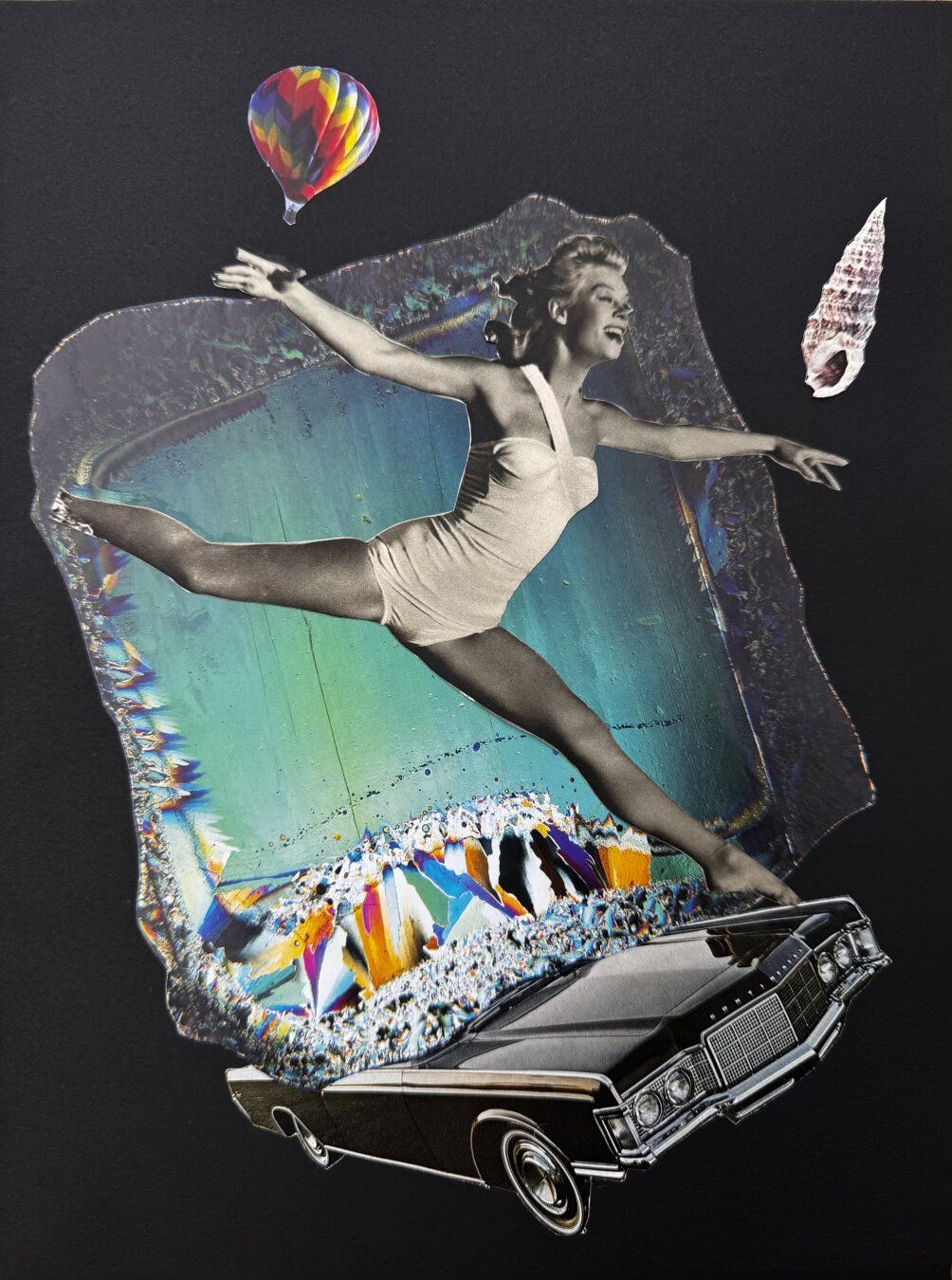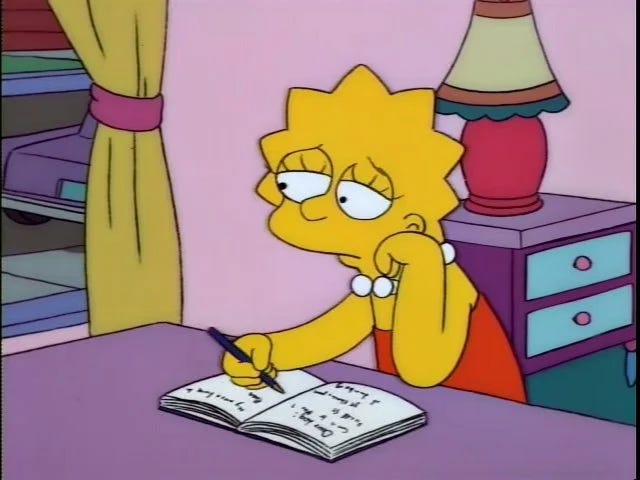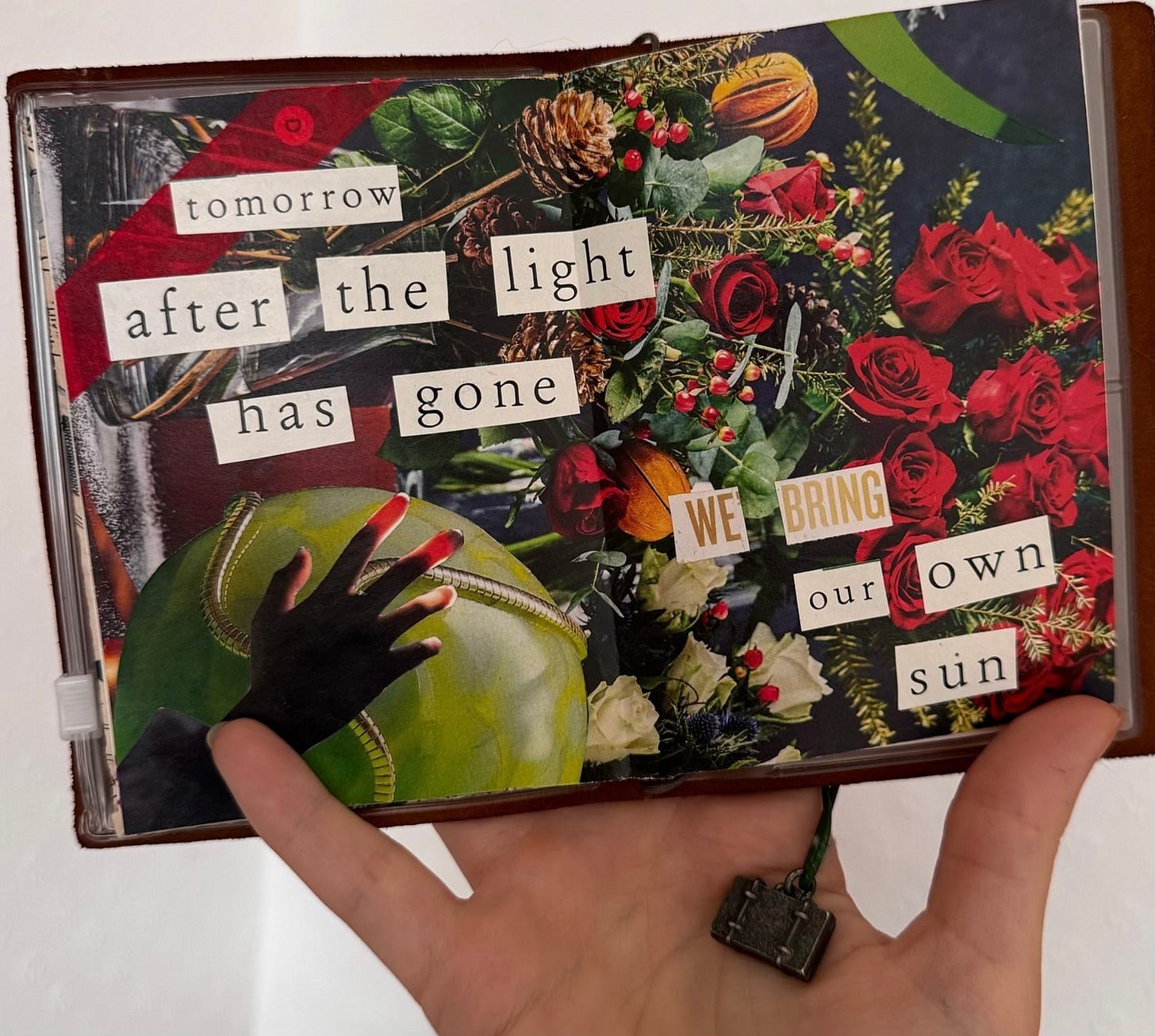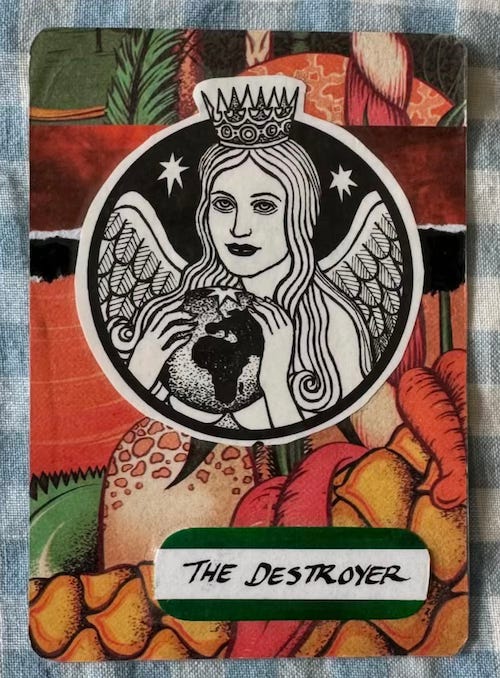Structure Without Restriction: Journaling to Balance Intention and Creativity
Startup marketing expert Lily Smart shares her three-part journaling system to decode emotions, explore hidden possibilities, and amplify joy
The Navel Gazette’s “How I Journal” series asks journalers around the world how and why they sustain a personal writing habit. Today’s edition features Lily Smart, who pairs her role as a marketing lead in a London tech startup with a richly tactile journaling practice to determine what to build, what to keep, and what to discard.
🔔 Reminder: Early Bird Pricing for the Summer Journaling session ends July 2. Register here:
“The joy of journaling is you can make whatever you want. There is no wrong system.”
- Lily Smart
Getting Started: Inspired by The Simpsons
Growing up in Hertfordshire, England, Lily’s decision to start journaling was inspired by watching cartoon icon Lisa Simpson confide in her diary.
“As a very small kid, I saw that Lisa had a diary where she would retreat into herself and have a private world,” she remembers. “I thought, ‘I want something like that!’”
While her initial entries took on the “Dear Diary” structure of recounting the day, her journal gradually evolved to become both a strategic tool and a mode of discovery.
“As I’ve gotten older I have used it to manage my productivity, energy, and mood, and to quite intentionally ground myself,” she explains. “At the same time, if I’m trying to find my way around an idea, I’ll just free-form notes on what I’m writing about. So journaling also became, at a certain point, melded with my creative practice.”
One for Intention, One for Exploration, One to Let Go
“The joy of journaling is you can make whatever system you want and there is no wrong system,” Lily says. Her current setup has three components:
A written journal for decoding emotions and recognizing joy, gratitude, and wins
An “art journal” for exploring nascent ideas through multi-media collage
“Disposable” notebooks for Morning Pages-style brain dumps
For her written and art journals, she uses refillable inserts within a leather cover. The continuity of the covers is “grounding,” she explains: “I really like the permanence of coming back to the same thing.”
In contrast, for her stream-of-consciousness practice, shedding the completed notebooks has a valuable symbolic meaning. “I can leave my old self behind,” she jokes, quick to add that releasing constraints does not really mean abandoning younger versions of Lily. “You’re always with you,” she emphasizes.
INTENTION: Clarity, Joy, Gratitude, and Wins
Lily’s structure for her written journal includes sections for “intentional discovery” as well as a daily practice of recording experiences in three categories:
Joy - delightful moments of beauty and connection that take her by surprise
Gratitude - beloved aspects of her life that continue to support her
Wins - celebrations of her own efforts to grow and contribute
This daily practice helps her to “expand the positive as part of my landscape,” she explains. “It helps me teach myself better ways of thinking and counter what I know are some mental habits I’d rather not have.”
The more investigative component of her written journal focuses on processing emotional challenges and decoding what she refers to as “feelings about the feelings.”
“Sometimes my emotional response is making the situation feel much bigger than it is,” she explains. “This type of journaling helps me get through those meta-feelings to the root of it.”
“My body was saying, ‘This is scary, this is bad, this is a threat. Shut down. Go to sleep.’ It was only through journaling that I worked through the fog to see what was happening.”
For example, in a previous job, Lily found herself exhausted whenever she was at work, although she was getting sufficient rest and felt fine on the weekends. Rather than jumping to the conclusion that she needed a career transition, she traced her feelings “back to the initial splash” to locate the precise source of her exhaustion.
“Something was happening at work that was shutting me right down. My body was saying, ‘This is scary, this is bad, this is a threat to you. Shut down. Go to sleep.’ It was only through journaling that I worked through the fog to see what was happening,” she says.
Lily was able to isolate the source of the shut-down sensation: internal politics at that workplace. “Making that legible enabled me to renegotiate how I was engaging, change what could be changed, and not take the rest personally,” she says.
EXPLORATION: Visual Mood
Whereas her written journaling practice generally begins “with a purpose in mind,” Lily’s collage-based art journals build from a mood or feeling.
“In the art journal, it’s less that I am trying to work through something I know, and more that I am trying to work towards something I don’t yet know,” she says.
“It’s less that I am trying to work through something I know, and more that I am trying to work towards something I don’t yet know.”
The completed image, which may or may not incorporate an idea expressed in words, “does feel emotionally true even if it’s abstract,” she says.
In contrast to the writing practice that helps her sort through challenges and redirect her attention, her open-ended art journal helps her honor an imaginative impulse: “It’s like I’m playing in a world that I’m creating at the same time.”
LETTING GO: Space for Release
Lily’s “disposable” notebooks are where she discharges unwanted negativity. Following the practice described by Julia Cameron in The Artist’s Way, she’ll allow space for a “rant,” she says.
“The whole idea is not to think too much,” Lily says. “It’s just for getting things out of my head.”
Unlike the careful nurturing of her written and art journals, Lily allows this practice to come and go as needed. “I’ll sometimes write Morning Pages consistently for weeks, then not for months at a time,” she says.
When each of these notebooks is filled, she discards it. She observes, “I notice toward the end of the book I tend to get a bit sloppy as I really am eager to move on.”
Sustaining Commitment and Experimentation
Having journaled in various forms for decades, Lily is careful to balance a commitment to the practice with a willingness to shift her approach over time.
For example, to keep the experience fresh, she sometimes incorporates tools like tarot and oracle decks. “I don’t use them in a fortune-telling way,” she explains, “but more to try a different lens can I apply to the situation. It helps me switch up the entry point into the problem and nudge me out of my usual pathways.”
When considering advice she would give others who are interested in journaling, Lily is adamant that personalization and creative freedom are available to everyone.
“Journaling can seem like this big, structured thing that you have to learn how to do,” she says. “But really, it’s whatever you want it to be. You can access it from any angle. You can be very unrestricted in your own approach.”
“It’s like I’m playing in a world that I’m creating at the same time.”
Resources and Opportunities for Journalers
🖼️ See more from Lily’s art journal:
https://www.instagram.com/lily.onpaper
📖 Craft your own journaling practice in a live summer cohort: https://elisabethandrews.com/journaling
🗞️ Share your journaling experiences with the Navel Gazette:
Reach out by email: elisabeth.andrews@gmail.com.
More in the “How I Journal” series:
Meet other journalers and start your summer system
☀️ Summer Journaling Booster - Starts July 12 🖊️
Join for daily prompts, supportive live sessions, a warm and welcoming group, and a private podcast — all designed to get you back in the groove of a rewarding personal writing practice. Enroll by July 2 for Early Bird Pricing.













Loved the idea of different kind of journals for different things especially the stream of consciousness. I also didn't realize that I thought of journaling as a structured thing. Insightful article my friend!